‘Jeanne Samary Week’ (like ‘Shark Week’, but with cuter teeth) was inspired by a question about Jeanne Samary’s dress in Renoir’s full length portrait of her:
I recreated the dress, and a reader wanted to know about the original gown. Who made it? What did it look like? Did it actually exist?
This is my interpretation:
Clearly I don’t have Samary’s enviable figure, but in all other ways I’m happy with my dress as a recreation of what Samary’s dress might have been.
So, what do we know about Samary’s actual dress?
Well, for one, it probably existed. Renoir was known to paint dresses that did exist, and did belong to the models he knew. The same frocks are repeated in various paintings in numerous paintings by Renoir and other Impressionist artists. Samary, for example, is shown in the same dress in The Swing and dancing in the Bal du moulin de la Galette, and Renoir and Monet both painted Monet’s wife Camille in a blue robe/tea gown. And, as seen in Tuesday’s ‘Rate the Dress’ Samary was painted in outfits that really existed.
There is also a sketch of Samary that seems to show her in the same frock:
I love the details of the white lace around the neck and sleeves, and also, that the sketch clearly shows her holding a Japanese fan, which is exactly what I thought would go with her dress!
Based on comparison with fashion plates and with other paintings, we can assume that the gown is an evening gown, worn to balls, the theatre, and salons. Numerous paintings of the era show the sleeveless frocks in these settings. The more commonly seen 3/4 length sleeves, low square necked dresses were reception gowns. How women danced in the long sweeping trains is a wonder!
There is one painting from 1878 that shows women in similar dresses at a salon:
And Mary Cassatt did three works from the era with women in these type of gowns at the theatre:
It’s clear that Samary favoured this style and cut of gown, as the same cut is seen in Reverie.
We don’t know who the dress was by. It might have been a Worth, but there were any number of other dressmakers operating in Paris in the 1870s.
We can gain insight into Samary’s dress by looking at paintings from the same era as Jeanne Samary’s portrait that also depict women in evening gowns.
The neckline in this dress is more off the shoulders than Jeanne’s almost square-necked dress, but the front ruching is similar, and the treatment of the train is eerily similar to what I have done (I wasn’t familiar with this work when I made my Jeanne dress)
The pink frock has a back neckline which indicates that it was somewhat closer to Jeanne’s dress, and the general silhouette of the dress is also similar. Plus, it gives a lovely glimpse of the shoes!
For a detail of ballgown bodices circa 1878, we can look at a work by Morisot:
Or one by Sargent:
It’s interesting that Jeanne’s dress is completely devoid of flowers, as these seem to be such a feature of other evening gowns of the era.
As well as depictions of wealthy society women, there is even a painting of another stage personality in an evening dress/ballgown:
In Manet’s work we see the lovely roundness of front and back that were so typical of corseted figures at the time. We can’t tell what Samary’s side figure looks like in her portrait, but it is reasonably to assume that she would also have had the lovely swell below her waist: not my flat front.
Finally, moving a little latter in time, another work by Renoir shows us the back view of a dress similar to Samary’s.


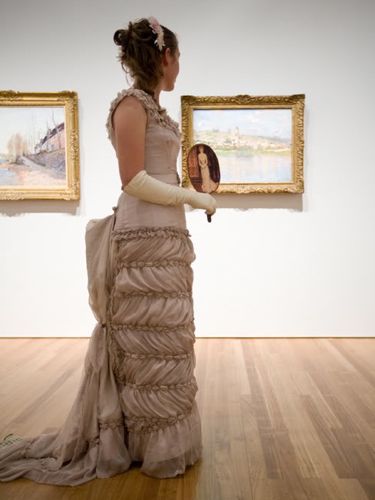


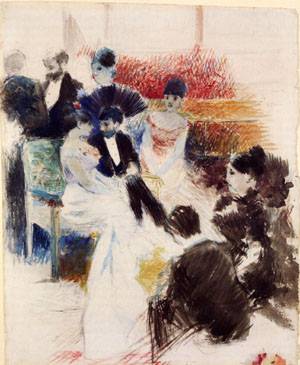



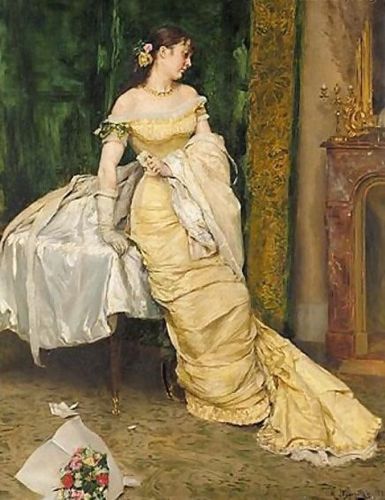
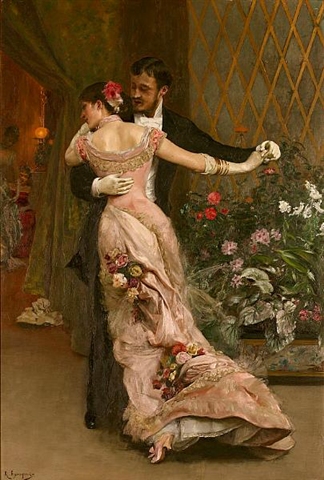
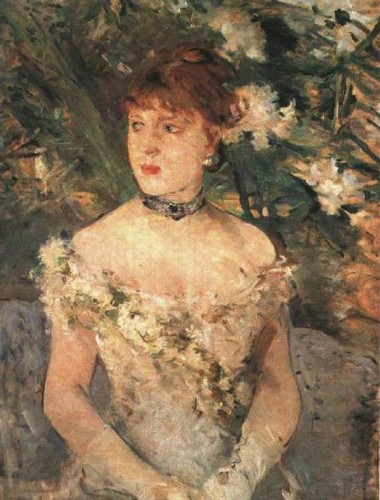

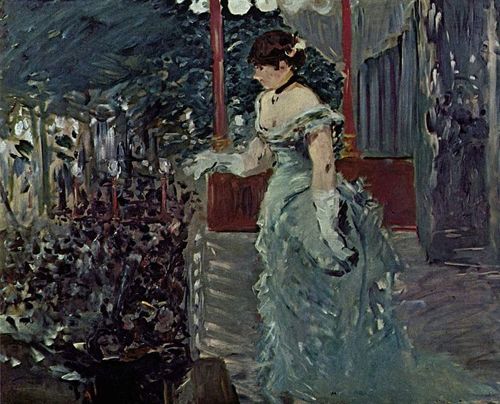

just what I’ve always loved about impressionism–it takes the hard edges of life and makes it all soft and fuzzy. I believe the same is true of the dress. You do very fine work.
I have enjoyed your series on Jeanne Samary! I portrayed her in a history presentation a couple of years ago but I didn’t know her name until now! I homeschool my kids and we were studying Impressionism and all the history and literature of the late 19th century. We do history presentations on our favorite person every nine weeks, where I try to recreate costumes for us to wear. My historical interpretation was about Queen Liiuokalani, where I recreated a black sleeveless gown she wore. After I made my costume, I got the idea to also become one of the dancers from Renoir’s dancing paintings. I chose the very painting you show of Jeanne dancing…except the gown was white. I had no idea how to recreate that, I still needed the black for Queen L., but I wanted to do a second interpretation of Jeanne, so I just figured she sat/danced for another one in a black gown! I stepped out of the painting and looked at my audience and taught them about my experience of dancing and being painted by Renoir…teaching about Impressionism. I tried to make a French accent, use French phrases, everything. It was fun to do both Queen L and Jeanne! I’ve always wanted to recreate the white gown. Perhaps someday I can figure it out. But thank you for sharing these posts about her!
Laurie
How long did it take you to make the dress???
I want to learn how to do this!